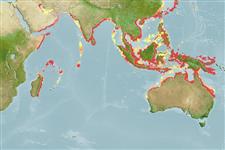分類 / Names
共通名の | 類義語 | Catalog of Fishes(部類, 種) | ITIS | CoL | WoRMS | Cloffa
>
Carangaria/misc (Various families in series Carangaria) >
Polynemidae (Threadfins)
Etymology: Eleutheronema: Greek, eleutheros = free + Greek, nema = filament (Ref. 45335).
More on author: Shaw.
Environment: milieu / climate zone / depth range / distribution range
生態学
海; 新鮮な水; 汽水性の; 両側回遊性 (Ref. 51243); 深さの範囲 0 - 23 m (Ref. 6390). Tropical; 32°N - 26°S, 47°E - 154°E (Ref. 57343)
Indo-Pacific: Persian/Arabian Gulf, Pakistan, India and Sri Lanka (except the Red Sea and East Africa) to northern Australia and New Guinea. Replaced by Eleutheronema rhadinum (Jordan & Evermann, 1902), in East Asia (Japan, China, Viet Nam) (Ref. 41639).
Length at first maturity / サイズ / 重さ / 年齢
Maturity: Lm ?, range 29 - ? cm
Max length : 200 cm TL オス/雌雄の選別がない; (Ref. 3479); common length : 50.0 cm TL オス/雌雄の選別がない; (Ref. 3479); 最大公表体重: 145.0 kg (Ref. 4965)
背面の脊椎 (合計): 9; 背鰭 (合計): 13-15; 肛門の骨 3; 臀鰭: 14 - 16; 脊つい: 25. This species is distinguished with the following characters: second dorsal fin soft rays 14 (rarely 13 or 15) pectoral fin rays 16-18 (mode 17, rarely 15 or 19), pectoral filaments 4; pored
lateral line scales 71-80 (mode 73); scale rows above lateral line 9-12, below 13-15 (14); vomer with deciduous tooth plates on both sides, except in juveniles (< ca. 7.0 cm SL); posterior part of maxilla deep, 3-4% of SL; short tooth plate extension onto lateral surface of lower jaw, 7-9% SL. Colour of upper sides of head and trunk with slight darkish silver tinge, becoming lighter in lower sides; anterior margins of first and second dorsal fins blackish, remaining parts translucent and slightly blackish, respectively; pectoral fin membranes vivid yellow in life, except in large specimens > ca 35 cm SL which is dusky yellow; pectoral filaments white; anterior margin of pelvic fin yellow and other parts white; base of caudal fin yellowish, other parts blackish (Ref. 41639, 57343).
Adults occur mainly over shallow muddy bottoms in coastal waters. Also enter rivers (Ref. 3479, 6390, 11230). Juveniles found in estuaries. During winter, adults ascend the rivers. They usually form loose schools, although larger fish are more often observed in pairs or singly (Ref. 6390). Feed on prawns and fish (largely members of Mugilidae, Engraulidae, and Sciaenidae) with occasional polychaetes. Frequency of crustaceans to fish in the diet varies seasonally. Larvae (7-30 mm TL) feed mainly on copepods and mysids but also take shrimps and prawn larvae (Ref. 57343). Juveniles (31-60 TL) feed on prawns shrimps and mysids (Ref. 57343). Protandrous hermaphrodites. Marketed fresh, frozen, and dried or salted.
Life cycle and mating behavior
成熟 | 繁殖 | 放精 | 卵 | 生産力 | 幼生
In Australia, fish are males at 24-47 cm FL, hermaphrodites at 25-46 cm FL and females at 28-72 cm FL. On the northeast Queensland coast, most blue threadfin are females by 45-50 cm FL. Hermaphroditic blue threadfin develop fom 1-2-year-old fish, and females first appear as 2-3-year-old individuals (Ref. 28736). Male fish probably commence sex reversal immediately after spawning (ie about April-May) and this condition may persist until after the next spawning period (Ref. 28736). The progression from hermaphrodites to females is complete by the following season.
There is little information on the larvae, although nursery areas are known to be lower estuaries, tidal swamps and lagoons, and shallows along the foreshores (Williams 1997).
Motomura, H., Y. Iwatsuki, S. Kimura and T. Yoshino, 2002. Revision of the Indo-West Pacific polynemid fish genus Eleutheronema (Teleostei: Perciformes). Ichthyol. Res. 49(1):47-61. (Ref. 41639)
Human uses
水産業: 高い商業の; 水産養殖: 商業
より多くの情報
協力者画像Stamps, Coins Misc.音シガテラ(食中毒の名前)速度泳ぐ 型式カマOtoliths脳視覚
用具
特記事項
XMLをダウンロードして下さい
インターネットの情報源
Estimates based on models
Preferred temperature (Ref.
123201): 25.2 - 29.3, mean 28.6 °C (based on 2815 cells).
Phylogenetic diversity index (Ref.
82804): PD
50 = 0.6250 [Uniqueness, from 0.5 = low to 2.0 = high].
Bayesian length-weight: a=0.00617 (0.00400 - 0.00951), b=3.06 (2.93 - 3.19), in cm total length, based on LWR estimates for this species & (Sub)family-body (Ref.
93245).
栄養段階 (Ref.
69278): 4.1 ±0.5 se; based on diet studies.
回復力 (Ref.
120179): 手段, 1.4年~4.4年の倍増期間の最小個体群 (Fec=680,000; assuming tm>=2).
Prior r = 0.56, 95% CL = 0.37 - 0.84, Based on 2 stock assessments.
Fishing Vulnerability (Ref.
59153): Very high vulnerability (90 of 100).
Climate Vulnerability (Ref.
125649): Very high vulnerability (91 of 100).
Nutrients (Ref.
124155): Calcium = 38.1 [12.5, 117.4] mg/100g; Iron = 0.744 [0.292, 1.866] mg/100g; Protein = 20 [18, 22] %; Omega3 = 0.122 [0.065, 0.224] g/100g; Selenium = 52.9 [18.1, 162.0] μg/100g; VitaminA = 15.1 [5.7, 40.9] μg/100g; Zinc = 0.92 [0.46, 1.74] mg/100g (wet weight); based on
nutrient studies.
